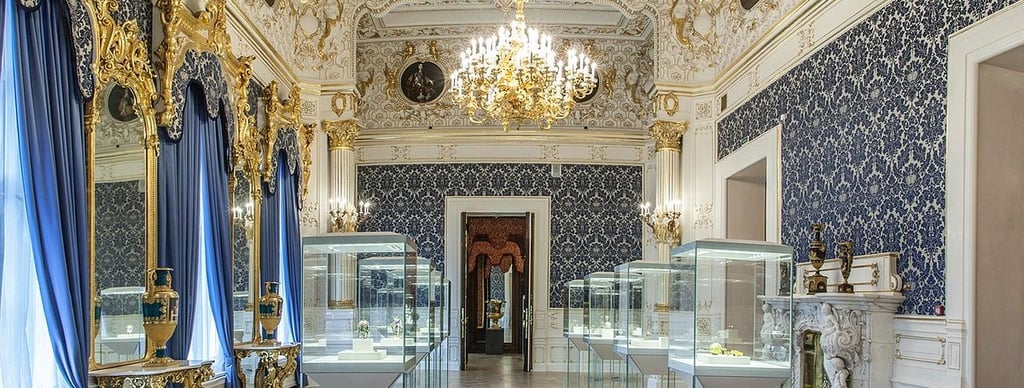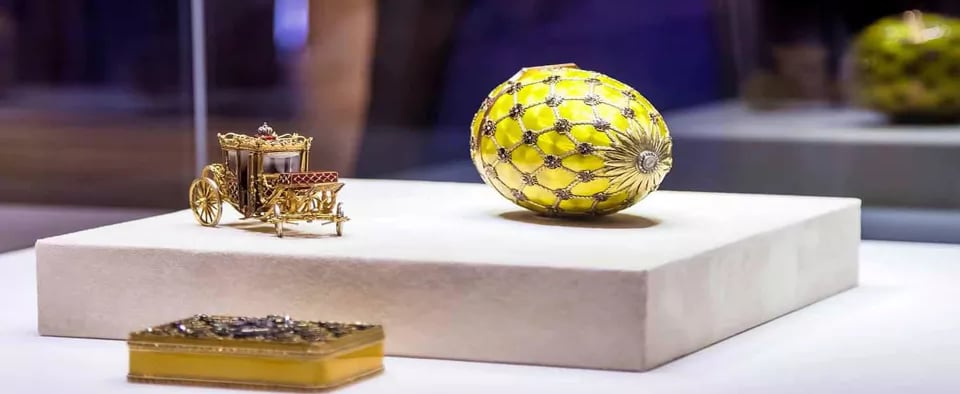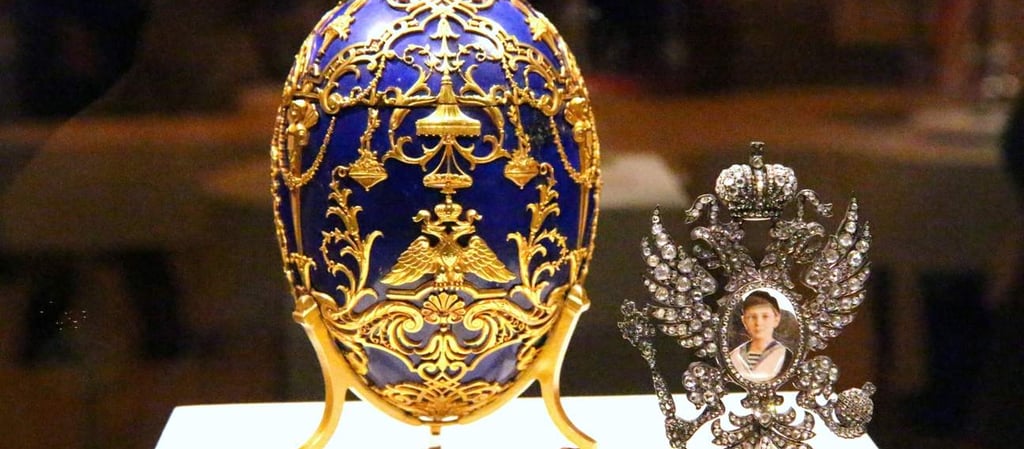Fabergé Museum: Jewels of Empire, Echoes of Elegance
Singular institution where art and opulence converge, where every gemstone tells a story, and where the most famous eggs in the world shimmer with secrets of a bygone age.


A Palace Reborn
The Fabergé Museum is housed within the Shuvalov Palace, a masterpiece of neoclassical and baroque architecture that sits gracefully along the Fontanka River. The palace itself is a work of art — a place where marble staircases, gilded ceilings, and silk-draped salons once hosted Russia’s elite.
For decades after the revolution, the building languished, its grandeur fading beneath layers of dust and neglect. But in the early 21st century, a remarkable restoration breathed new life into its halls.
This revival was spearheaded by the Link of Times Foundation, established by Russian philanthropist Viktor Vekselberg. In 2004, Vekselberg purchased the celebrated Malcolm Forbes Collection of Fabergé masterpieces — including nine of the fabled Imperial Easter Eggs — and pledged to return these icons of Russian artistry to their homeland.
The result is the Fabergé Museum, which opened in 2013 and has since become one of the cultural jewels of Saint Petersburg — and of Russia itself.
The Man Behind the Magic: Peter Carl Fabergé
At the heart of this glittering narrative stands a man of vision and virtuosity: Peter Carl Fabergé.
Born in 1846 in Saint Petersburg to a family of Huguenot descent, Fabergé inherited his father’s jewelry firm and transformed it into one of the most celebrated houses in Europe. Trained in art and craftsmanship, he fused technical mastery with artistic daring, elevating the jeweler’s craft to the level of fine art.
By the late 19th century, Fabergé’s creations graced the salons of Moscow, Paris, and London. Yet it was his relationship with the Russian Imperial Court — beginning in 1885, when Tsar Alexander III commissioned the first Imperial Easter Egg — that secured his enduring fame.
These eggs, and countless other Fabergé works, embodied a unique aesthetic: luxurious yet playful, precise yet whimsical, timeless yet utterly of their time.
The Imperial Easter Eggs: Art Beyond Imagination
The soul of the Fabergé Museum’s collection lies in its nine Imperial Easter Eggs — jeweled marvels that once delighted the Russian empresses and dazzled European connoisseurs.
Each egg was a world unto itself: a miniature cosmos of enamel, gold, platinum, diamonds, sapphires, and rubies. Each contained a hidden surprise — a tiny mechanical swan, a clockwork coach, a portrait gallery, or a musical automaton.
To behold these eggs today is to glimpse the pinnacle of decorative art and the grandeur of the Romanov dynasty. Among the highlights:
The Hen Egg (1885)
The first Imperial egg, gifted by Alexander III to Empress Maria Feodorovna, opens to reveal a golden yolk, within which rests a golden hen, which in turn contains a miniature crown and a ruby pendant.
The Renaissance Egg (1894)
Inspired by a 16th-century watch, this egg is a study in architectural elegance, enamel artistry, and intricate design.
The Coronation Egg (1897)
Commissioned by Nicholas II for Empress Alexandra Feodorovna, this egg of yellow enamel holds a miniature replica of the coronation coach used in the Tsar’s crowning — a marvel of engineering and symbolism.
The Lilies of the Valley Egg (1898)
Delicate sprays of enamel lilies rise from the egg’s surface, each petal studded with diamonds. Within, portraits of the Tsar and his children emerge when a hidden mechanism is activated.
The Bay Tree Egg (1911)
Perhaps the most whimsical of all, this egg takes the form of a jeweled tree, whose branches conceal a singing bird that appears when wound.
Each egg is a poetic fusion of art, love, and power — a testament to the singular genius of Fabergé and the boundless resources of the Russian Empire.
Beyond the Eggs: The World of Fabergé
While the eggs are the stars, the Fabergé Museum offers a vast panorama of the House of Fabergé’s craftsmanship. The collection spans more than 4,000 objects, each a masterpiece of its kind.
Jewelry and Accessories
Bracelets, tiaras, brooches, and cufflinks — each piece bearing the signature Fabergé touch: a marriage of elegant design and peerless technique.
Enamel and Miniatures
Fabergé’s guilloché enamel — layers of translucent color over intricately patterned metal — remains unmatched. Visitors encounter a dazzling array of snuffboxes, frames, and miniature objets d’art that display this signature technique.
Silver and Tableware
Everyday objects — tea sets, serving dishes, cigarette cases — were transformed by Fabergé’s artisans into objects of beauty. In the Fabergé Museum, the line between utility and art disappears.
Religious Art
From ornate icons to enameled crosses, Fabergé brought reverence and refinement to ecclesiastical commissions, blending the sacred and the sumptuous.
Stone Carvings
Perhaps the most charming section of the museum is its collection of hardstone animals — miniature sculptures of dogs, cats, elephants, and birds, carved from precious stones with lifelike precision and wit.
These pieces remind us that Fabergé’s genius embraced both the profound and the playful.
Practical Information
Location
Fabergé Museum
Fontanka River Embankment, 21, Shuvalov Palace, Saint Petersburg, Russia
Opening Hours
Daily: 10:00 – 20:45
Ticket office closes at 20:15
Closed on some public holidays (check official website).
Tickets
Available online or at the museum entrance.
Guided tours in Russian and English are available.
Audio guides in multiple languages are also offered.
Public Transport
Metro: Gostiny Dvor or Mayakovskaya stations are nearby.
Buses and trams serve the Fontanka River area.
Accessibility
The museum is wheelchair accessible.
Special services for visitors with disabilities can be arranged.
Visitor Services
Museum shop offering Fabergé-inspired jewelry, books, and gifts
On-site café with riverside views
Cloakroom and visitor assistance
Educational programs and lectures for adults and children
For current exhibitions, ticket booking, and virtual tours:
https://fabergemuseum.ru


Craftsmanship and Legacy
What distinguished Fabergé’s workshop from its many imitators was not simply wealth of materials, but a relentless pursuit of perfection and innovation.
Under Peter Carl Fabergé’s leadership, the House employed over 500 master craftsmen — goldsmiths, stone carvers, enamellers, engravers, and watchmakers — each trained to the highest standards of the European and Russian decorative arts.
The workshop pioneered techniques such as:
Guilloché enamel: a signature style of layered translucent enamel applied over intricate engine-turned patterns.
Miniature mechanisms: tiny automata and clockwork surprises hidden within jewelry and eggs.
Realism in stone carving: bringing astonishing lifelikeness to figurines of animals and flowers.
Yet beyond technique, Fabergé’s greatest legacy is one of artistic spirit — an ability to infuse even the most lavish objects with human warmth and poetic imagination.
In an era of imperial display and ostentation, Fabergé’s creations whispered of joy, love, humor, and intimacy. A smile lies within every egg; a story waits behind every jewel.
The Fall of an Empire, the Survival of Art
The outbreak of World War I, the chaos of revolution, and the fall of the Romanov dynasty brought a sudden end to Fabergé’s golden age.
In 1918, the Bolsheviks nationalized the House of Fabergé. Peter Carl fled into exile; many of his craftsmen scattered. Imperial treasures were seized, sold abroad, or lost to history.
Yet the objects themselves survived — cherished by collectors, guarded in museums, sought after in secret. The saga of the Imperial Eggs is one of dispersal and rediscovery: pieces surfacing in private collections, Soviet state vaults, and international auctions.
It is thanks to these twists of fate, and the vision of collectors like Viktor Vekselberg, that the Fabergé Museum today can reunite so many of these masterpieces on Russian soil, where they once delighted empresses and tsars.
The Fabergé Museum Today
Visiting the Fabergé Museum is a multi-sensory experience — part treasure hunt, part historical meditation, part aesthetic feast.
Each room of the restored Shuvalov Palace has been carefully curated to evoke both the grandeur of the imperial age and the timeless beauty of the objects. Velvet-lined vitrines display the eggs and jewels in soft, flattering light. Period furniture and restored murals provide historical context. Interactive displays offer deeper insights into Fabergé’s life, techniques, and clientele.
The museum also hosts temporary exhibitions, drawing on other Russian and international collections to explore broader themes of decorative art, jewelry history, and imperial culture.
Its research and conservation programs contribute to global scholarship on Fabergé and the Russian decorative arts. The museum publishes catalogues, hosts conferences, and collaborates with other institutions worldwide.
A Place of Beauty and Reflection
In an age of mass production and virtual experience, the Fabergé Museum offers something increasingly rare: a direct encounter with craftsmanship of the highest order.
Here, one is reminded of the power of the handmade, the enduring magic of beauty wrought from the earth’s most precious materials. Each egg and object whispers not only of imperial opulence, but of the human longing to create, to delight, to transcend the ordinary.
Yet the museum also invites reflection. These treasures evoke a lost world — an empire of unimaginable wealth and inequality, whose glittering courtly life ended in revolution and tragedy.
To walk these halls is to sense the poignancy beneath the brilliance: a lesson in the fragility of fortune, the impermanence of power, and the enduring power of art.




